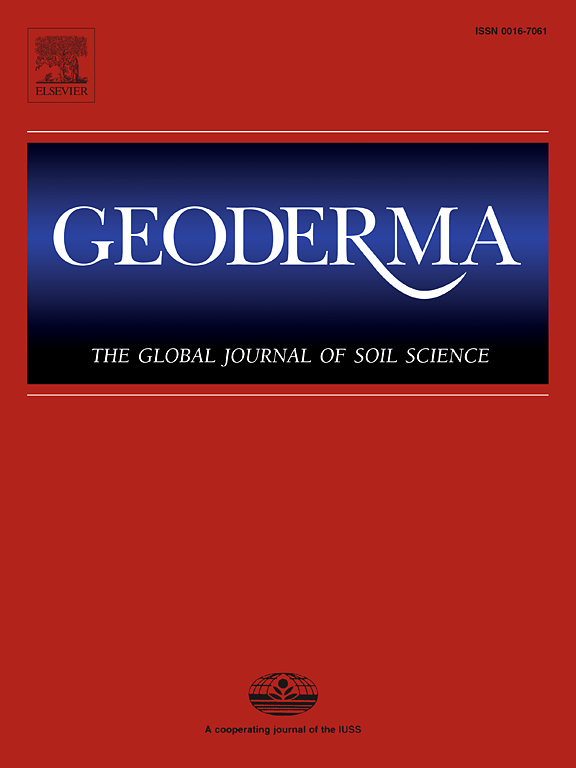Woodchip-filled trenches: A solution to enhance urban water infiltration capacity?
IF 5.6
1区 农林科学
Q1 SOIL SCIENCE
引用次数: 0
Abstract
Urban water management has been increasingly relying on infiltration to limit the environmental impact of stormwater, secondary treated effluent and gray water. The infiltration systems used are generally based on non-renewable drainage materials featuring a pronounced ecological footprint (i.e., excavation and transport), such as gravel. This paper investigates the possibility of using woodchips instead of traditional drainage materials. Our study examines flow dynamics in woodchip-filled infiltration trenches at four decentralized gray water sites, on a silty clay soil. Infiltration tests were conducted using the Beerkan method to measure soil infiltration capacity both beneath the woodchip-filled trenches and in adjacent soil. Soil hydraulic functions were determined according to the BEST method, then comparisons were drawn between the woodchip-filled trench and natural soil. Results indicate that woodchips locally maintain or enhance soil infiltration rates, with a hydraulic conductivity up to 200 times higher in woodchip-treated soil. Additional soil measurements and analyses serve to formulate hypotheses on how the woodchips actually contribute to these effects. Dye tracer experiments revealed preferential pathways facilitated by macro fauna (earthworms) and, most likely, plant roots. This last information input has been corroborated since earthworm counts did prove to be significantly higher in the woodchips than in the soil. A chemical analysis of the soils also showed a significant enrichment of carbon and nitrogen under the trench, which may also improve soil structure and stability and perhaps indirectly enhance water infiltration capacity. In summary, the presence of woodchips in infiltration trenches improves the soil hydraulic conductivity at saturation for systems that have been in use for 5 to 10 years. These findings underscore the potential of woodchips in sustainable urban water management in order to enhance the functionality and efficiency of drainage materials by means of limiting the clogging effect.
木屑填充沟渠:提高城市渗水能力的解决方案?
城市水资源管理越来越多地依靠渗透来限制雨水、二级处理污水和灰水对环境的影响。所使用的渗透系统通常基于不可再生的排水材料,具有明显的生态足迹(即挖掘和运输),如砾石。本文研究了使用木屑替代传统排水材料的可能性。我们的研究考察了在四个分散式灰水站点的淤泥质粘土上,木屑填充渗透沟中的水流动力学。采用 Beerkan 方法进行了渗透测试,以测量木屑填充沟渠下方和邻近土壤的土壤渗透能力。根据 BEST 方法确定了土壤的水力功能,然后对填充木屑的沟渠和天然土壤进行了比较。结果表明,木屑可在局部保持或提高土壤的渗透率,木屑处理过的土壤的水力传导率最高可提高 200 倍。更多的土壤测量和分析有助于就木屑究竟如何产生这些效果提出假设。染料示踪实验显示,大型动物(蚯蚓)以及很可能是植物根系促进了优先路径。最后一项信息输入得到了证实,因为事实证明木屑中的蚯蚓数量明显高于土壤中的蚯蚓数量。对土壤进行的化学分析还显示,沟渠下的碳和氮含量明显增加,这也可能改善土壤结构和稳定性,并可能间接提高水的渗透能力。总之,在已使用 5 到 10 年的系统中,渗沟中木屑的存在提高了饱和状态下的土壤导水性。这些发现强调了木屑在可持续城市水管理中的潜力,通过限制堵塞效应来提高排水材料的功能和效率。
本文章由计算机程序翻译,如有差异,请以英文原文为准。
求助全文
约1分钟内获得全文
求助全文
来源期刊

Geoderma
农林科学-土壤科学
CiteScore
11.80
自引率
6.60%
发文量
597
审稿时长
58 days
期刊介绍:
Geoderma - the global journal of soil science - welcomes authors, readers and soil research from all parts of the world, encourages worldwide soil studies, and embraces all aspects of soil science and its associated pedagogy. The journal particularly welcomes interdisciplinary work focusing on dynamic soil processes and functions across space and time.
 求助内容:
求助内容: 应助结果提醒方式:
应助结果提醒方式:


